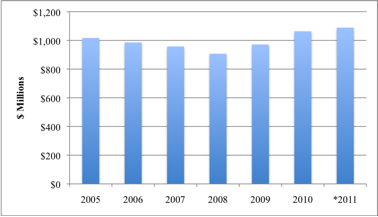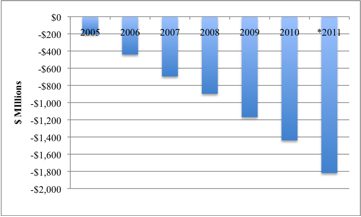
By Craig Cox, EWG midwest vice-president, and Nils Bruzelius, executive editor.
You hear plenty of talk about the ballooning federal deficit created by tax cuts, two wars and the effort to dig out of the economic meltdown, but precious little about the funding gap that’s hollowing out federal programs designed to protect America’s soil and water.
An economic recovery and prudent fiscal policies will begin to chip away at the budget deficit, but you can’t replace lost soil with dollar bills. And cleaning up polluted waterways and marine dead zones will take years or decades, if you can do it at all.
That’s why it’s so disturbing that for the second year in a row, President Obama’s budget is falling short in funding Department of Agriculture programs designed to curb the erosion of precious soil and reduce the damage caused by nutrient and chemical runoff from agriculture. To date, USDA’s Environmental Quality Incentives Program (EQIP) has been the most important program providing money and technical assistance to help farmers and ranchers reduce their environmental impact.
The administration is saying we should be happy because its proposed $1.208 billion EQIP budget for 2011 would be an increase over the 2010 figure. But that argument completely misses the big picture. In fact, the 2011 request is $380 million below what was mandated in the laboriously negotiated 2008 farm bill, and it barely brings the program back to the neighborhood where it was supposed to be in 2005. In inflation-adjusted real dollars, the 2011 request is actually $123 million less than the promised -- but never delivered -- 2005 allocation.
Yes, the 2011 number is $72 million more than what EQIP actually got in 2005 (in real dollars), but that’s not much solace when you look at what’s happening on the ground, and in the water. Here are what EQIP’s spending history looks like since then:
Requested EQIP Funding Barely Gets Us Back to Where We Were in 2005
*Administration’s recommendation for 2011.
So what, you say? There are so many other unfilled needs.
Well, think about this: The numbers tend to lag behind, but as of 2003, more than 100 million acres of cropland were eroding at rates faster than the “soil loss tolerance level,” which is based on the depth of soil and its ability to grow a crop. (The data come from USDA’s National Resources Inventory of non-federal land.) That’s 100 million acres of soil, stuff that takes geological eons to create, being washed or blown away – for good.
There’s more to say about the impact on soil loss and water quality, but first, back to those budget numbers. Just as with the federal deficit, the persistent failure to fund conservation programs adequately has created a national conservation debt. That’s EWG’s cumulative measure of how far EQIP funding has fallen below the levels promised when the program was conceived. Every one of those missing dollars is a missed opportunity to limit agriculture’s environmental impacts and preserve those resources for future generations.
Here’s how that other national debt has grown:
America’s Conservation Debt Has Soared Since 2005
*Administration’s recommendation for 2011.
It adds up to a total deficit of $1.819 billion – and an increase of 26 percent just from 2010 to 2011 -- if the Obama request goes through. So the funding falls further and further behind, but nothing slows the pace of erosion and water contamination linked to agriculture.
In the case of EQIP alone – and other federal conservation programs also face cuts – the budget request means that we lose the opportunity to protect soil and water quality on nearly 3 million acres of farmland.
The impact on water quality will be felt far from any farms, of course. The notorious “dead zones” in the Gulf of Mexico and Chesapeake Bay are only the most obvious examples. Those vast watery deserts, so barren of oxygen that little or no marine life can survive in them, are caused in large part by the poorly managed fertilizer and pesticide runoff from farms. In the case of the Gulf, 80 percent of the phosphorus and 66 percent of the nitrogen that sucks the life from thousands of square miles of ocean is directly traceable to agricultural sources. In the case of the Bay, the comparable figures are 45 percent of the phosphorus and 43 percent of the nitrogen. That’s based on a report of the Environmental Protection Agency’s (EPA) State-EPA Nutrient Innovations Task Group.
There are so many other troubling numbers documenting the toll that agriculture-linked contamination takes on the nation’s streams, rivers, lakes and oceans it can be eye-glazing. To spare you, here’s a very small sample.
- 100 percent -- increase in drinking water violations because of nitrate contamination between 1998 and 2008
- 72 percent -- percentage of private wells contaminated with nitrate, 1991 to 2004
- 103,577 miles – of rivers and streams rated as impaired, probably by agriculture
- 1,579,540 – number of similarly impaired lakes, reservoirs, and ponds,
- 2,885 – number of similarly impaired bays and estuaries
- 383,822 – number of similarly impaired wetlands
Eyes not glazed yet? Here’s where those numbers, and a lot more, come from:
US EPA Watershed Assessment, Tracking & Environmental Results
US EPA Wadeable Stream Assessment
USDA Economic Research Service Briefing Room: Irrigation and Water Use
Congress and the Obama Administration need to do what it takes to keep this conservation debt from growing any bigger.





